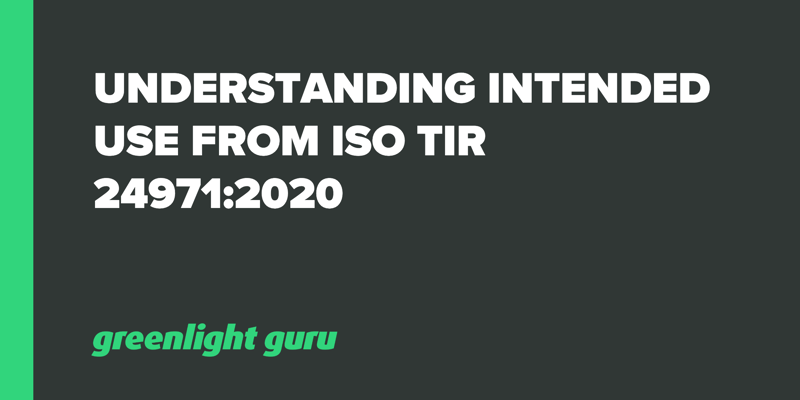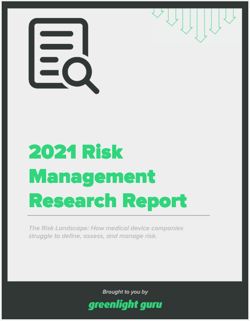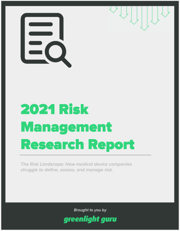
If you haven’t yet got into ISO TIR 24971:2020, there’s a fair bit to read up on.
This recent document is the latest iteration of the companion document to ISO 14971 and contains important context for medical device companies. There are new terms and definitions, additional risk management guidance, and more detailed requirements.
Intended use is quite a large topic and is part of ISO TIR 24971:2020. Here, I’m summarizing some of the key information for medical device companies to consider:
FREE DOWNLOAD: Click here to download our 2021 Risk Management Research Report.
What is ISO TR 24971?
The ISO TR 24971:2020 is the companion document or technical report for ISO 14971. You can look at it as an equivalent to one of FDA’s guidance documents - the purpose of the technical report is to provide the reader with additional details and context about specific parts of the standard from which it is associated.
ISO 14971:2019 is the latest version of the medical device risk management standard, providing industry professionals with a holistic approach for identifying, assessing, and controlling the risk associated with a medical device.
TIR 24971:2020 is for all intents and purposes a complete rewrite of the previous version it replaced. You’ll find that some elements that were previously written into ISO 14971 have since been shifted to annexes in TIR 24971:2020 (such as in vitro diagnostic devices, risk management plans, risk concepts and techniques, and guidance on hazard identification).
Having talked with folks involved with the working group who authored the documents, my take is that the committee observed that the industry needs a bit more guidance in putting risk management strategies in place. This is a key purpose behind TIR 24971:2020.
Annex A: Intended use and reasonably foreseeable misuse
Annex A of TIR 24971:2020 covers the identification of hazards and characteristics related to safety. A key question within Annex A is, what is intended use?
Intended use is an important thing to understand and to define with respect to your medical device. A good way to think about it is in terms of what your product claims to do. It is also a determining factor in how your product will be classified by regulatory agencies.
With respect to risk management activities, it’s important to understand the context of intended use as a framework for how you are assessing and evaluating risk. When and how might people use your device? What sort of abnormal uses can you envisage? Do things like off-label factor in?
The standard has this notion of “reasonably foreseeable misuse,” with that term sounding relatively ambiguous. It can be potentially interpreted as accidental misuse, but you could also infer that someone sees another application for your product outside of what you intended.
When would you be identifying these situations? Risk in general should be an innate part of your product development process. Usually, when you have an idea for a new product, you’re thinking about what problem you want to try and solve - adjacent to intended use. You probably think about that problem before you think of a solution and it informs what you should be doing from a risk management perspective.
At what point does reasonably foreseeable misuse come in? I think it should factor in early on, when you have an idea of the problem you’re trying to solve and you map out the flow and use of the product. You should include the environment, the user, and anything that might lead to reasonably foreseeable misuse.
It’s a bit of a slippery slope and I hesitate to be too prescriptive on how and if or whether you capture that information. There are pros and cons to capturing that information, and pros and cons to not doing it. It’s ultimately a business decision and you need to consider all ramifications of doing or not doing it.
How to determine intended use and indications for use
TIR 24971 Annex A is a helpful resource for manufacturers in that it outlines several key things to consider for determining intended use for your medical device. For example, what is the medical device’s role with regard to:
-
Diagnosis, prevention, monitoring, treatment, or alleviation of disease,
-
Diagnosis, monitoring, treatment or alleviation of or compensation for an injury,
-
Investigation, replacement, modification, or support of anatomy or a physiological process, or — control of conception?
Indications for use are also an important factor to consider. This information includes patient population, user profile, and use environment. Contra-indications should also be considered. (Remember that intended use and indications for use are two clear and separate statements).
Additionally, think about whether your device is intended to sustain or support life. Will special intervention be necessary if the device were to fail? These factors will impact the severity of risk.
If your medical device is connected to the cloud, you might also consider whether there is any risk related to data security breaches or cyberattacks. Could any loss of data impact device safety?
FREE DOWNLOAD: Click here to download our 2021 Risk Management Research Report.
Manage risk with the only medical device QMS aligned with ISO TR 24971
Greenlight Guru’s QMS software is the only solution built specifically for medical devices with a dedicated risk management workflow that also integrates with your design controls and other quality ecosystem, keeping you in compliance with the new risk management standard.
Get your free demo of our Risk Management Software now →
Looking for a design control solution to help you bring safer medical devices to market faster with less risk? Click here to take a quick tour of Greenlight Guru's Medical Device QMS software
Jon Speer is a medical device expert with over 20 years of industry experience. Jon knows the best medical device companies in the world use quality as an accelerator. That's why he created Greenlight Guru to help companies move beyond compliance to True Quality.
Related Posts
What are the Changes to ISO 14971:2019 & TR 24971?
Timeline to ISO 13485:2016 (And Why You Need to Act Today)
12 Medical Device Experts Offer Best Tips for How to Succeed in 2021
Get your free PDF
2021 Risk Management Research Report











